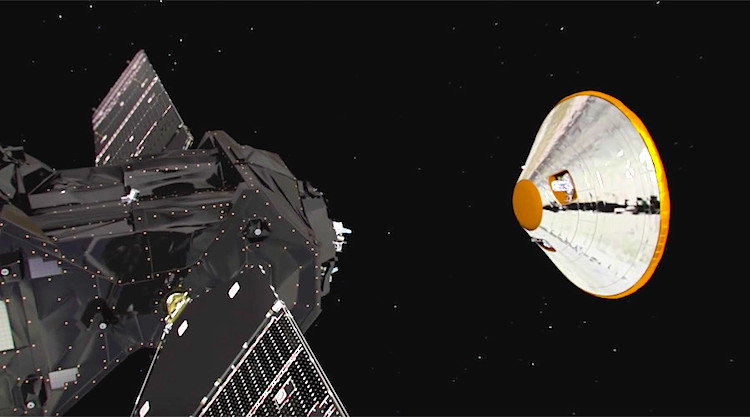
© ESA Robotic Exploration of Mars / YouTube
Despite the Schiaparelli test-landing sequence not going completely as expected, the ESA considers its ExoMars 2016 mission a success.
The lander stopped communicating with the TGO orbiter after detaching its parachute.The Schiaparelli reached the Mars surface, but the European Space Agency (ESA) is yet
not sure about its current condition, journalists were told during a press conference on Thursday. Nevertheless the craft translated a huge amount of data from its sensors to the orbiter during the descent. The ESA said that since the landing was meant as a technology test, it considered it's the Schiaparelli part of the mission a success despite the loss of signal.
The landing sequence
deviated from the nominal expectations during the transition from the parachute phase to the breaking thruster firing phase, about 50 seconds before the planned soft landing. The thrusters did fire for several seconds, observation from the orbit confirmed, but the ESA was not sure whether all of them fired as planned, the agency told journalists.
The Trace Gas Orbiter (TGO), the other part of the ExoMars 2016 mission,
is no longer in an orbit allowing monitoring Schiaparelli landing site, which is how the mission was expected to proceed. Other craft orbiting the Red Planet will be observing the surface and trying to pick a signal from the lander in the days to come, while the Schiaparelli's battery lasts.
The ESA will need about a week to analyze the landing data and may be able to tell more about what exactly happened with the Schiaparelli. Preliminary analysis says the parachute phase proceeded nominally up to the last moment, when the chute was ejected.
"In terms of the Schiaparelli test module, we have
data coming back that allow us to fully understand the steps that did occur, and
why the soft landing did not occur," David Parker, ESA's Director of Human Spaceflight and Robotic Exploration. "From the engineering standpoint, it's what we want from a test, and we have extremely valuable data to work with. We will have an enquiry board to dig deeper into the data and we cannot speculate further at this time."
The TGO orbiter was deployed in orbit as planned and confirmed its capability to serve both as a
scientific instrument platform and a relay station for a future 2020 mission, when the agency plans to land a rover on Mars. The ESA considers that part of ExoMars 2016 a milestone.
"Following yesterday's events we have an impressive orbiter around Mars ready for science and for relay support for the ExoMars rover mission in 2020," said Jan Worner, ESA's Director General. "Schiaparelli's primary role was to test European landing technologies. Recording the data during the descent was part of that, and it is important we can learn what happened, in order to prepare for the future."
The ExoMars mission is conducted by the ESA in corroboration with Russia's Roscosmos.

Reader Comments
to our Newsletter